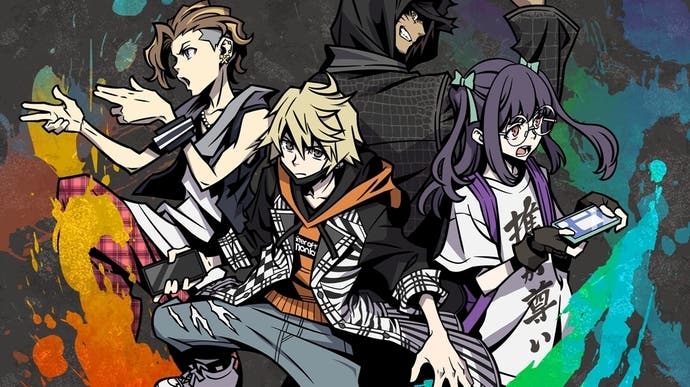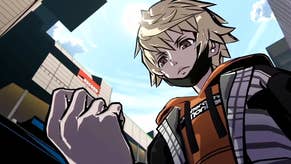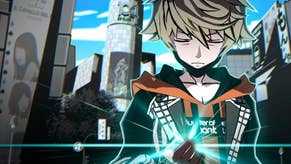NEO: The World Ends With You review - a DS classic gets a charmer of a sequel
Fret not.
Tokyo is the largest city on the planet, and for my first few trips there, it also felt like the busiest. I mean busiest in the sense of the sheer amount of visual information that lives around you when you walk around Shibuya: signs, screens, lettering, graffiti, municipal mascots. It's a complete delight to take in - maximalist and overwhelming. I'm sure it settles down the longer you spend there, but I've always been in and out. In a way, I don't want it to settle down. And it's this kind of thing that NEO: The World Ends With You is so brilliant at capturing.
The sequel to a glorious DS oddity, Neo is another RPG set in the Shibuya area of Tokyo, fanning out from the iconic Scramble Crossing to take in skyscrapers, crooked shopping lanes, freeway underpasses and much more. Tokyo, a certain kind of Tokyo; this city is vast and multifaceted, is captured in its hectic splendour. This is the same turf that Jet Set Radio explored - at times you can recognise the paving or the cant of a famous building - and it's the same emotional territory too: a world of teens and fashion and brands and shopping and friendship and phone messages and pop culture references.
But that maximalist visual onslaught! You get it twice, I reckon: firstly as you navigate the streets where the game's story and missions play out, and secondly when you're battling - the part of the game where its fiery soul lives. Where to look! The first game on DS had you air-hockeying your attention between the top screen and the bottom as you controlled different fighters with different input methods - button taps on one, stylus swipes on the other - and took on a variety of tattooed frogs and hawks and other wildlife. Neo keeps a lot of this in play. A lot of the enemies are familiar, particularly upfront, and a lot of the attacks you collect and level up, delivered in the form of pin badges, have come across from the earlier game too. But no two screens. No stylus. What to do? Where to look?
It would feel topsy-turvy going into the combat system before talking of the story and all that other jazz, but Neo remains a wonderfully topsy-turvy game. So here goes. In Neo you control a gang of fighters at any one time in combat, each with a different badge powering their attacks. Badges come with distinct inputs, so by the time you have four people to control, you'll have a triangle guy, a square guy, and a couple of bumpers or triggers. I like to lead with the triangle - generally sharp repetitive taps that blast out strikes or slashes of a glittering blade, perhaps. Square backs them up with lightning, or magical arrows say, and then I can hit the bumpers and triggers to heal, if I'm feeling cautious or boring, or to bring an iceberg spearing out of the ground, the bigger the berg the longer I charge the button.
Throw in dodging, and the fact that the spiky menageries you face off against like to attack in mix-and-match packs, and you've already got enough to think about. But Neo is just getting started. At the top of the screen is a Groove meter that builds up as you lay down attacks. Here's how it works: hit baddies with one move until you get a combo timer, and then switch to a different move and keep the combo going until you get another combo timer telling you to switch again. When the Groove meter fills you get to pull off a special move, and as that erupts - fireballs, ice shards, roving Top of the Pops lightning strikes - you can be building your meter afresh. It never has to end.
What you're balancing - and here's where the question of where to look really comes in - is the cooldowns for each badge and its attack. So while you're jabbing with the triangle you're working your way closer to a cooldown. Can you time it with a switch to a different party member and a different attack before you break the chain? And can you keep switching to keep ahead of the recharge periods? And can you do it while keeping an eye on incoming attacks, on which party member has been incapacitated by a jellyfish, and on what your groove meter is doing?

I love the battling, which only continues to add gleeful complexity as the story chugs onwards. And even from the off, it looks so beautiful. Neo's art style is visual excess: thick black lines, anime heroes, trend-wave haircuts and wonderfully detailed youth fashions. Inevitably, your attacks fit in: massive laser blasts, torrents of flame, glittering magic. And the enemies! I particularly like a shark from the game's early stages who likes to swim about under the sidewalk and then erupts. Jellyfish are always a sign that you're going to be busy - they like to split in two - and then there are bosses, the best of which I can't talk about, but one of which left me sobbing with laughter. By the end of the game's first act, target prioritisation is one of many more things you have to think about, and then come enemies who have to be attacked from a certain angle. Oh yes, and there are the enemy teams.
This is where the story comes in. As with the first game, you and your team of friends are basically dropped into a sort of metaphysical reality TV game show. Marooned on an interdimensional island of Shibuya landmarks, you are at the mercy of a bunch of Reapers, hipster games masters who divide your life into days and then weeks as you battle other teams to come out on top. Each day there's a new mission - a series of puzzles, perhaps, a cryptic instruction to achieve some task, or a territory capture game that sees you racing all over the map battling monsters and other teams. At the end of the week, one team wins and, well, the team at the bottom really loses.
What this amounts to is a gleeful excuse to pitch one gloriously odd stereotype against another. Rival teams are regular intruders in the soapy plotline that quickly builds up around your attempts to understand the Reapers' game and stay alive. I particularly love the team who are obsessed with rivers - but what kind of rivers? - and the big meany who sees all of life as a game of Reversi. The plot works hard keeping you angled against other teams while feeling a certain empathy, as they plot and counter-plot against you, everyone desperate not to be at the bottom by the end of the week. Your mobile is constantly pinging with updates on other teams' progress, and even though it's tightly scripted, it feels very alive, like there's a modern world out there constantly changing around you.
It's not just the teams. Frequently a task will involve you exploring Shibuya and influencing the lives of passersby, who can't see you or talk to you while you're playing the Reapers' game. Some are affected by bad emotions, which you obligingly battle for them, taking out the monsters that prey on their souls. Some need a moral prompt or a reminder, which you can do by popping into their minds and constructing basic thoughts for them one word at a time, or solving puzzles to implant memories. At times - one moment in particular - the game really struggles with the implications of this stuff, but just as often it's warm and funny, and offers to players like me a welcome glimpse of preoccupations in a distant city.

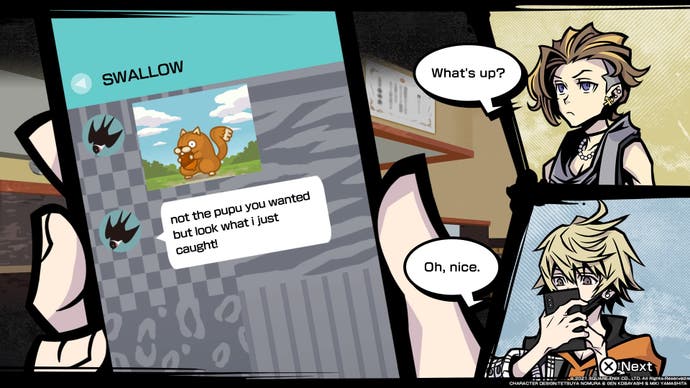
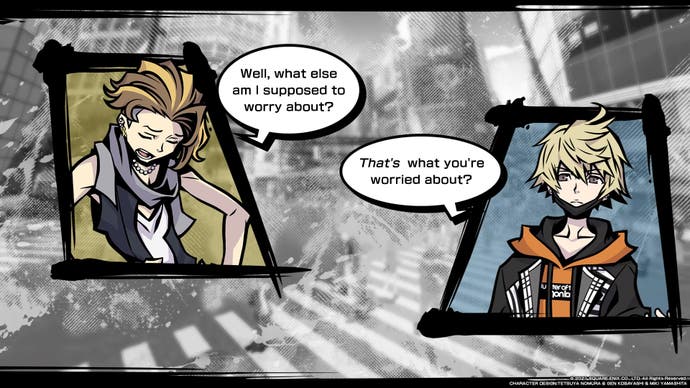
Tokyo! If battling is one of Neo's trumps, the city is the other biggy - it's just a treat to explore Shibuya and environs, carved into neat little sections, all slotting together while retaining their own identities. Simply looking around is beautiful - the game has powerful tourism cred - but then there are the pedestrians, whose thoughts you can read by stepping into another realm, where you can also chain monsters to pull together some massive battles. There are shops to buy gear that improves your stats (you can level up the shops to get better stuff) and restaurants that boost your stats permanently, but require cooldowns if you over-eat. Each of these establishments has its own character and its own goods available. I will never tire of eating the delicious looking cheese burgers at Scramble Crossing, and I spent twenty minutes the other day just trying to remember where a specific bookshop was located. I didn't even need a book - I just wanted to browse.
Neo is surprisingly huge, despite the fact that its map is quite snug. There are all those pins to find and level up, of course, with their different attacks and different synergies. There are the rival teams to fight against and steadily come to understand. There's quite a lot of grinding when you hit difficulty spikes, and then there are all the clever bits of business - time travel, therapy dives - that are employed to spin battling and puzzling and travelling around into different missions. Yes, Neo can be quite repetitive, but for me its two trumps come to save the day. For one thing, backtracking across Shibuya, looking at all the shops and the people and the landmarks, never grew old as it might if I was backtracking across a generic fantasy world - and it opened up plenty of opportunities for puzzles that involve looking quite hard at the urban environment, one middle-act example being particularly amusing. For another thing, those battles are just such enormous fun, bordering at times on rhythm-action as you switch between one party member's attack and another, keeping the groove building, and hearing the wholesome encouragement of each of your team as you go. The hit-pause here is an absolute dream. You chew gloriously to each victory.
A setting like this can make everything new. Even a series of unlockable perks feels a bit special when it's dressed up as a web of your emerging social networks, with nodes you unlock by feeding in friend points to people you have met. Those badges unleash brilliant attacks and can level up and evolve, but they also just look incredibly collectable, incredibly desirable. And while the storytelling can be pretty verbose at times, the characters are neatly drawn and everything chatters along with the ping of incoming texts and status updates.
Occasionally I get a wonderful twinge, too. I have been to Shibuya personally, stayed for one visit in a hotel across from the Scramble Crossing, and I get the odd shock of recognition playing Neo. But more often I get that sense of worlds glancing against worlds - the world of Neo shuffling past the world of Jet Set Radio. I don't think I could ever get to know a place as vast as Tokyo, but in games you get a wonderful angled view of it. This is a generous game indeed.
